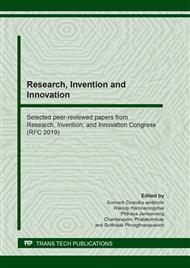[1]
C.F. Chiu, W. Zhu, C.L. Zhang, Yielding and shear behaviour of cement-treated dredged materials, Eng. Geol. 103 (2008) 1–12.
DOI: 10.1016/j.enggeo.2008.07.007
Google Scholar
[2]
R. Zentar, D. Wang, N.E. Abriak, M. Benzerzour, W. Chen, Utilization of siliceous-aluminous fly ash and cement for solidification of marine sediments, Constr. Build. Mater. 35 (2012) 856–863.
DOI: 10.1016/j.conbuildmat.2012.04.024
Google Scholar
[3]
N. Yoobanpot, P. Jamsawang, K. Krairan, P. Jongpradist, Reuse of dredged sediments as pavement materials by cement kiln dust and lime treatment, Geomech. Eng. 15(4) (2018) 1005–1016.
DOI: 10.1007/s11368-020-02635-x
Google Scholar
[4]
E. Silitonga, D. Levacher, S. Mezazigh, Utilization of fly ash for stabilization of marine dredged sediments, Eur. J. Environ. Civ. Eng. 14(2) (2010) 253–265.
DOI: 10.1080/19648189.2010.9693216
Google Scholar
[5]
A. Ghosh, U. Dey, Bearing ratio of reinforced fly ash overlying soft soil and deformation modulus of fly ash, Geotext. Geomembranes 27(4) (2009) 313–320.
DOI: 10.1016/j.geotexmem.2008.12.002
Google Scholar
[6]
S. Kolias, V. Kasselouri-Rigopoulou, A. Karahalios, Stabilisation of clayey soils with high calcium fly ash and cement, Cem. Concr. Compos. 27(2) (2005) 301–313.
DOI: 10.1016/j.cemconcomp.2004.02.019
Google Scholar
[7]
S. Horpibulsuk, C. Phetchuay, A. Chinkulkijniwat, Soil stabilization by calcium carbide residue and fly ash, J. Mater. Civ. Eng. 24(2) (2012) 184-193.
DOI: 10.1061/(asce)mt.1943-5533.0000370
Google Scholar
[8]
N. Yoobanpot, P. Jamsawang, S. Horpibulsuk, Strength behavior and microstructural characteristics of soft clay stabilized with cement kiln dust and fly ash residue, Appl. Clay Sci. 141 (2017) 146–156.
DOI: 10.1016/j.clay.2017.02.028
Google Scholar
[9]
S. Horpibulsuk, C. Phetchuay, A. Chinkulkijniwat, A. Cholaphatsorn, Strength development in silty clay stabilized with calcium carbide residue and fly ash, Soils Found. 53(4) (2013) 477-486.
DOI: 10.1016/j.sandf.2013.06.001
Google Scholar
[10]
P. Voottipruex, P. Jamsawang, Characteristics of expansive soils improved with cement and fly ash in Northern Thailand, Geomech. Eng. 6(5) (2014) 437-453.
DOI: 10.12989/gae.2014.6.5.437
Google Scholar
[11]
ASTM C 618: Standard specification for coal fly ash and raw or calcined natural pozzolan for use as a mineral admixture in concrete, Annual Book of ASTM Standard, Section 4 Construction, Volume 04.02 Concrete and Aggregate.
DOI: 10.1520/c0618-00
Google Scholar
[12]
ASTM D 2166: Standard Test Method for Unconfined Compressive Strength of Cohesive Soil, West Conshoshocken, PA, United States.
Google Scholar
[13]
ASTM D3967: Standard Test Method for Splitting Tensile Strength of Intact Rock Core Specimens, West Conshoshocken, PA, United States.
DOI: 10.1520/d3967-08
Google Scholar
[14]
P. Jamsawang, H. Poorahong, N. Yoobanpot, S. Songpiriyakij, P. Jongpradist, Improvement of soft clay with cement and bagasse ash waste, Constr. Build. Mater. 154 (2017) 61–71.
DOI: 10.1016/j.conbuildmat.2017.07.188
Google Scholar
[15]
S. Horpibulsuk, R. Rachan, A. Suddeepong, Assessment of strength development in blended cement admixed Bangkok clay, Constr. Build. Mater. 25(4) (2011) 1521-1531.
DOI: 10.1016/j.conbuildmat.2010.08.006
Google Scholar
[16]
D.B. Eme, J.C. Agunwamba, Tensile strength of natural and lime stabilized clay soil in Rivers State using one indirect tensile testing technique (Splitting test), Int. J. Eng. Sci. 3(4) (2014) 38-45.
Google Scholar
[17]
D. Wang, N.E. Abriak, R. Zentar, Strength and deformation properties of Dunkirk marine sediments solidified with cement lime and fly ash, Eng. Geol. 166 (2013) 90–99.
DOI: 10.1016/j.enggeo.2013.09.007
Google Scholar


